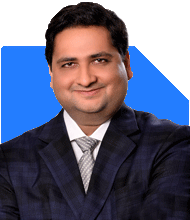32-Year-Old with 50k Monthly Salary: How to Start Investing?
Ramalingam Kalirajan |10874 Answers |Ask -Follow
Mutual Funds, Financial Planning Expert - Answered on Nov 01, 2024
He has an MBA in finance from the University of Madras and is a certified financial planner.
He is the director and chief financial planner at Holistic Investment, a Chennai-based firm that offers financial planning and wealth management advice.... more

Hi am 32 yr old 50k per month salary need further advice for investment as i havent invested yet
To guide you, here’s a detailed approach to starting your investment journey in a systematic, sustainable way.
1. Build Your Emergency Fund First
Starting with an emergency fund is essential. It creates a financial cushion for unexpected expenses and emergencies.
Aim to save 6-8 months of your monthly expenses. This should cover rent, bills, groceries, and healthcare.
Keep this in a high-interest savings account or a liquid mutual fund. It keeps funds easily accessible, avoiding disruptions to long-term investments.
2. Evaluate Your Monthly Budget and Savings Potential
Reviewing your budget will give clarity on how much you can save each month.
Track your monthly expenses and identify areas where you can cut down.
After setting aside your expenses, aim to save at least 20-30% of your income consistently.
This dedicated saving amount will go toward different investments.
3. Establish Insurance for Financial Security
Investing is crucial, but protection comes first. Without adequate insurance, your financial goals could face setbacks in case of any unfortunate event.
Term Insurance: Protect your family with a term insurance plan that covers at least 10-15 times your annual income.
Health Insurance: Ensure you have health insurance covering critical illnesses and hospitalization costs. Preferably go for a family floater plan if you have dependents.
4. Consider Long-Term Investment Goals
Define your long-term financial objectives. These goals could include:
Retirement corpus
Down payment for a home
Funds for children's education or marriage
Clearly defined goals help align your investments with specific time horizons and risks.
5. Start SIPs in Actively Managed Mutual Funds
Systematic Investment Plans (SIPs) in actively managed mutual funds allow you to begin investing with discipline and consistency.
Actively managed funds outperform index funds in most cases. They adapt to changing market conditions better.
Investing in SIPs offers the advantage of rupee-cost averaging and compounding, helping you build wealth steadily.
6. Avoid Direct Mutual Funds – Choose Regular Funds with a CFP
While direct funds appear cost-effective, they can lack guidance.
Investing through a certified financial planner (CFP) provides the benefit of professional insights.
A CFP offers ongoing portfolio management, helping you make the best decisions for market trends and personal goals.
Regular plans might have slightly higher costs, but the guidance from a CFP can outweigh these costs in terms of returns.
7. Set Up a Mix of Equity and Debt Mutual Funds
For a balanced portfolio, consider both equity and debt funds. Each category offers unique benefits:
Equity Mutual Funds: Ideal for long-term wealth creation, suitable for goals 5-10 years away. Choose diversified or flexi-cap funds for balanced growth.
Debt Mutual Funds: Good for short-term stability, these funds reduce risk and offer modest returns. Suitable for goals within 1-3 years.
This combination provides growth potential while balancing risks.
8. Tax Implications on Mutual Funds
Understanding tax implications is essential as it affects your returns.
Equity Funds: Long-term capital gains (LTCG) above Rs. 1.25 lakh are taxed at 12.5%. Short-term gains are taxed at 20%.
Debt Funds: Both LTCG and STCG are taxed based on your income slab. Holding debt funds for a longer period can reduce the tax impact.
Having a CFP manage your tax liabilities can maximize your returns.
9. Set Financial Milestones for Different Life Stages
Plan your investments around major life events and responsibilities.
In 5 Years: Aim to achieve short-term goals such as travel or higher education.
In 10-15 Years: Focus on long-term goals like buying a house or funding higher education for your children.
In 20+ Years: Prepare for retirement by investing in instruments that align with long-term growth.
10. Take Advantage of Tax-Advantaged Investment Options
Investing in tax-saving instruments helps you save taxes while meeting financial goals.
Public Provident Fund (PPF): Offers a secure, tax-free return, which is ideal for building a retirement corpus.
ELSS Mutual Funds: Equity-linked savings schemes allow for wealth creation while providing tax savings under Section 80C.
11. Consider National Pension System (NPS) for Retirement Planning
The National Pension System offers tax benefits and builds a retirement corpus.
With NPS, you can allocate funds across equity, corporate debt, and government securities.
NPS provides tax benefits under Section 80CCD and Section 80C.
Remember that retirement requires a significant amount, so an early start in NPS helps secure future comfort.
12. Automate Your Investments for Discipline
Automating your investments keeps you disciplined and consistent.
Set up automatic transfers for SIPs and other recurring investments. This approach ensures consistent contributions.
Regular investment prevents the temptation to spend on non-essential items.
13. Review and Adjust Your Portfolio Periodically
Investing is not a one-time activity. Your portfolio needs regular assessment.
Check your portfolio performance annually, ideally with a CFP. Regular reviews allow you to stay on track.
Adjust investments if there’s any change in personal circumstances, financial goals, or market conditions.
14. Final Insights
With a steady approach, a balanced portfolio, and financial protection, you can secure your financial future. Begin by saving regularly, investing in a disciplined manner, and reviewing your portfolio. These practices ensure you stay aligned with your goals.
Best Regards,
K. Ramalingam, MBA, CFP,
Chief Financial Planner,
www.holisticinvestment.in
https://www.youtube.com/@HolisticInvestment
You may like to see similar questions and answers below
Ramalingam Kalirajan |10874 Answers |Ask -Follow
Mutual Funds, Financial Planning Expert - Answered on Apr 05, 2023
Hardik Parikh | Answer |Ask -Follow
Tax, Mutual Fund Expert - Answered on May 04, 2023
Ramalingam Kalirajan |10874 Answers |Ask -Follow
Mutual Funds, Financial Planning Expert - Answered on Apr 12, 2024
Ramalingam Kalirajan |10874 Answers |Ask -Follow
Mutual Funds, Financial Planning Expert - Answered on May 18, 2024
Ramalingam Kalirajan |10874 Answers |Ask -Follow
Mutual Funds, Financial Planning Expert - Answered on Aug 03, 2024
Mayank Chandel |2569 Answers |Ask -Follow
IIT-JEE, NEET-UG, SAT, CLAT, CA, CS Exam Expert - Answered on Dec 08, 2025
Mayank Chandel |2569 Answers |Ask -Follow
IIT-JEE, NEET-UG, SAT, CLAT, CA, CS Exam Expert - Answered on Dec 08, 2025

Mayank Chandel |2569 Answers |Ask -Follow
IIT-JEE, NEET-UG, SAT, CLAT, CA, CS Exam Expert - Answered on Dec 08, 2025
Mayank Chandel |2569 Answers |Ask -Follow
IIT-JEE, NEET-UG, SAT, CLAT, CA, CS Exam Expert - Answered on Dec 08, 2025
Mayank Chandel |2569 Answers |Ask -Follow
IIT-JEE, NEET-UG, SAT, CLAT, CA, CS Exam Expert - Answered on Dec 08, 2025
Anu Krishna |1746 Answers |Ask -Follow
Relationships Expert, Mind Coach - Answered on Dec 08, 2025
Ramalingam Kalirajan |10874 Answers |Ask -Follow
Mutual Funds, Financial Planning Expert - Answered on Dec 08, 2025
Samraat Jadhav |2499 Answers |Ask -Follow
Stock Market Expert - Answered on Dec 08, 2025
Ramalingam Kalirajan |10874 Answers |Ask -Follow
Mutual Funds, Financial Planning Expert - Answered on Dec 08, 2025
Radheshyam Zanwar |6737 Answers |Ask -Follow
MHT-CET, IIT-JEE, NEET-UG Expert - Answered on Dec 08, 2025

























